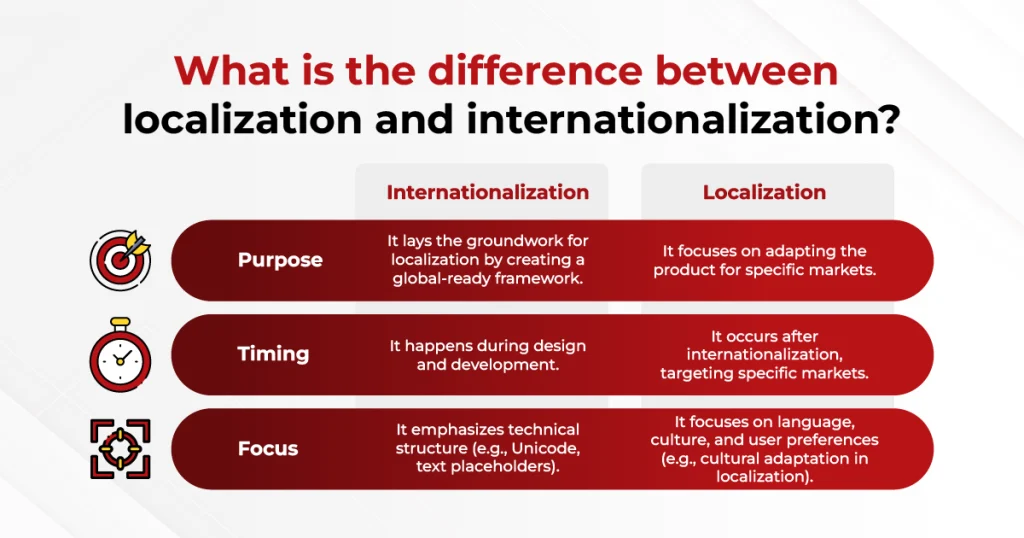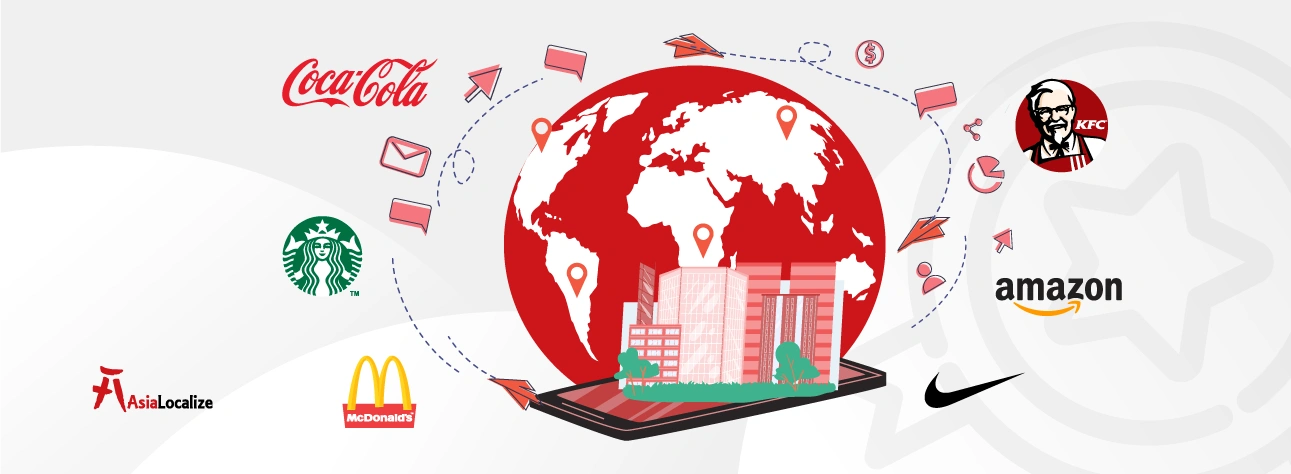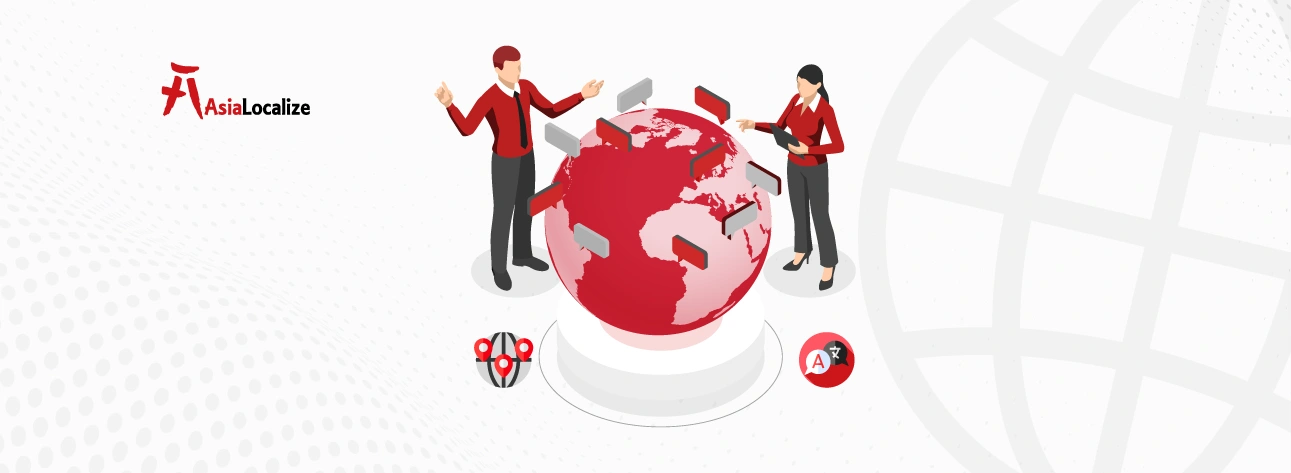Have you encountered the term “internationalization” but not quite sure what it means? You might think it’s the same as “localization.” However, internationalization and localization are distinct concepts.
While internationalization is the preparation phase that sets the stage for localization, they’re totally different processes, but working together towards one aim: creating globally-ready software.
To help you better understand the differences, we’ve created this guide “Localization vs. Internationalization.” It includes more than just the definitions; you will take a deeper look at how they work together to deliver memorable experiences for your global audience.
Understanding Localization vs Internationalization
i18n builds the foundation; l10n tailors it to fit. How?
Internationalization (i18n) is the process of designing a product or software to be adaptable to various languages and regions without requiring major changes.
It focuses on creating a flexible framework—think Unicode support, neutral code, or placeholder text—that makes future localization easier. For example, IKEA uses picture-only assembly guides to avoid language-specific text.
Localization (l10n) is the process of adapting content for local markets, including translating text and adjusting date formats, currencies, or cultural references. For instance, McDonald’s offers vegetarian options in India to suit local preferences.
I18n vs L10n: What’s the Difference?
At the heart of any global product strategy lies the interplay between two critical processes: internationalization and localization. While both are essential for crafting a universally appealing software product, they each serve distinct roles in the journey to global success.
What is the difference between localization and internationalization?
Why Do You Need Both for a Successful Global Product Strategy?
A successful global product strategy is not just about scaling up but about blending a nuanced understanding of local preferences with a cohesive brand vision.
Faster Global Expansion
Implementing internationalization for software streamlines the localization process, allowing companies to adapt their products more efficiently across various markets.
According to a study by the Localization Industry Standards Association (LISA), companies that invest in internationalization can reduce localization costs by up to 30%, enabling faster market entry.
For instance, apps like Spotify leverage robust internationalization frameworks, allowing them to launch simultaneously in multiple countries, ultimately decreasing time-to-market and increasing market share rapidly.
Enhanced User Experience
Tailored content resonates more with users, enhancing their overall experience. A report by Common Sense Advisory found that 72% of consumers are more likely to make a purchase if the product information is in their native language.
Improved Brand Reputation
A survey by CSA Research revealed that 56% of consumers believe that the availability of localized content enhances their perception of the brand, reinforcing the company’s commitment to its global customers.
Brands like Coca-Cola have successfully utilized this strategy, adapting marketing campaigns to reflect regional language preferences and cultural sensitivities, thereby strengthening their reputation and customer loyalty in diverse markets.
How Internationalization Works: A Quick Guide
Whether you’re a small startup or a large corporation, grasping the intricacies of internationalization can be pivotal in navigating the complexities of diverse markets and cultures.
Use Unicode for Multilingual Support
Encode characters to accommodate all languages, ensuring text displays correctly across different scripts.
Separate Text from Code
Utilize resource files for translatable content, making it easier to update and manage text without altering the core code of the application.
Design Flexible User Interfaces
Create interfaces that can accommodate variations in text length, especially for languages that may require more space, such as German, which can be up to 35% longer than English.
Automate Regional Adjustments
Implement automation for adapting currency, date formats, and units of measurement to align with local conventions seamlessly.
Test with Internationalization-Ready Software
Use tools like pseudolocalization to preview how content will appear in different languages, identifying potential issues before actual localization occurs.
| Ensure error-free translations with our Editing and Proofreading services. |
How Localization Works: Best Practices
Localization goes beyond mere translation; it involves a deep understanding of cultural nuances, regional preferences, and consumer behaviors.
Translate and Adapt Content
To achieve authentic and nuanced translations, hire native linguists with at least 5 years of experience in software localization. Their expertise ensures not only the accuracy of the language but also the relevance and sensitivity to cultural contexts.
Customize Visuals and Layouts
While in Western cultures, the color red is associated with feelings of excitement, risk, urgency, and love, it evokes danger and caution in the Middle East.
Adjusting your visuals to cultural nuances ensures your message resonates deeply with local audiences.
Optimize for Global SEO
By utilizing regional language preferences and incorporating targeted keywords, you can improve your search rankings. This not only attracts local traffic but also enhances your brand’s credibility in those markets.
Leverage Localization Management Platforms
Using Translation Management Systems (TMS) allows you to manage workflows, track progress, and ensure uniformity across various localized versions of your content.
Test Locally
Before launching your localized content, conducting thorough user testing in the target market is imperative. This process helps uncover potential cultural misunderstandings or functional issues that may not be apparent during development.
| Learn about our Translation Process to ensure accuracy and cultural relevance. |
Tools and Technologies for I18n and L10n
Leveraging the right tools is integral for streamlining both localization and internationalization processes. And understanding how these tools function can greatly enhance your ability to deliver a globally-ready product efficiently.
L10n and I18n Automation Tools
Streamline your workflows by utilizing automation tools that integrate translation, testing, and deployment processes. These tools help eliminate manual tasks, reduce human error, and speed up your product’s time-to-market.
Localization Management Platforms
Leverage advanced platforms designed to simplify the overall localization process and manage large projects efficiently. These platforms provide features such as workflow management, collaboration tools, and reporting, ensuring that all team members stay aligned.
Translation Memory Software
Use translation memory systems to store and reuse previously translated content. This ensures consistency across different projects and helps save valuable time by allowing translators to access established translations rather than starting from scratch.
Pseudolocalization Tools
Before diving into localization, utilize pseudolocalization tools to test how text expansion affects your UI design. These tools simulate the look and feel of a localized version by temporarily altering the text to assess layout flexibility and identify potential design issues early in the development process.
By laying a solid groundwork through internationalization, companies can facilitate smoother, more efficient localization processes tailored to diverse markets.
AsiaLocalize can help you in your next moves in the international market. With the help of our experts, we accelerate the process of your global expansion and deliver exceptional experiences for your target audience.
| Empower Your Brand Globally Request a Free Quote for Localization and Internationalization Services Today! |







